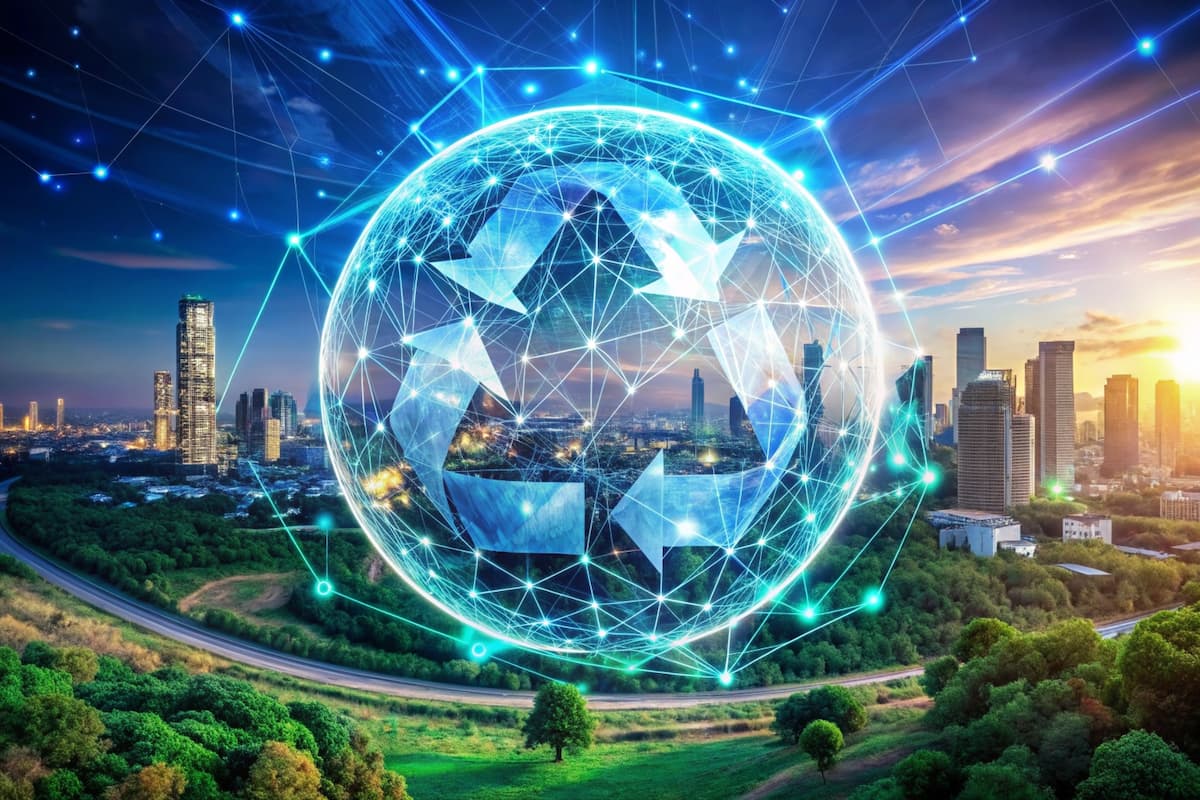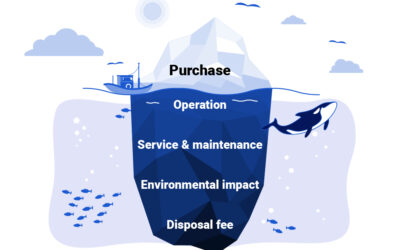You’re a techie, an innovator, a disruptor.
You want to change the world and make it better, not just for today, but for generations to come.
How can you do that?
By marrying two powerful emerging forces: artificial intelligence and the circular economy.
In this article, we’ll explore how AI can supercharge efforts to move from our wasteful linear economy to a closed-loop system.
Imagine intelligent robots that can repair, refurbish, and reuse products infinitely.
Or AI optimising material flows to eliminate waste entirely.
The possibilities are endless. Together, AI and circularity could revolutionise how we produce, consume and live sustainably.
Read on to have your mind blown by the potential of this dynamic duo to create a brighter future.
What Is a Circular Economy and How Does AI Enable It?
A circular economy aims to eliminate waste and maximize the lifespan of materials and products. Rather than the linear “take, make, dispose” model of production, a circular economy reuses materials and keeps products in use as long as possible.
AI Predicts What We Need
AI systems can analyze data to determine customer needs and predict demand for new sustainable products. With AI, companies can manufacture goods based on actual needs rather than overproducing. They can also customize products for customers, reducing waste.
Optimizing Renewable Energy Use
AI helps integrate renewable energy into the grid by predicting when the sun will shine and wind will blow. It can also optimize energy usage in factories and offices. With AI balancing supply and demand, we can transition to renewable energy and a greener economy.
Reducing Waste in Factories
AI powers technologies like predictive maintenance, which identifies machinery issues before they cause downtime. It spots inefficiencies on assembly lines and optimizes robot movements. AI also helps design components and products for reusability, like packaging made of compostable materials. All of this boosts productivity and cuts waste.
Keeping Products in Use Longer
AI powers recommerce platforms where people can buy pre-owned goods. It helps with reselling, renting, and repairing items so they stay useful for longer. AI also enables personalized product design so people grow attached to what they buy – meaning they hold onto it for longer before replacing it.
With AI and a collaborative effort, a sustainable future where resources are used efficiently and waste is designed out of the system is possible. Together, AI and the circular economy could help ensure we have enough for generations to come.
Benefits of the Circular Economy and AI
AI technologies are uniquely positioned to help enable and accelerate the transition to a circular economy. Here are some of the major benefits:
Optimized Resource Use
AI can analyze data across the supply chain to pinpoint inefficiencies and optimize resource use. For example, AI may determine that a manufacturing process requires 20% less material or an office building could reduce energy usage by 30% through smart HVAC systems. These insights can help companies dramatically reduce waste and environmental impact.
Predictive Maintenance
AI excels at detecting patterns and anomalies. Manufacturers can use AI to predict when equipment needs maintenance or replacement parts, reducing unplanned downtime and waste. AI may determine that a machine component will likely fail within the next 6-12 months, allowing time to repair or replace it. This predictive ability helps extend the useful life of products and cuts down on waste.
Accelerated Innovation
AI technologies can generate initial designs and prototypes faster than any human. Engineers can use AI to rapidly test new ideas and get feedback, speeding up the development of products, components and materials specifically designed for a circular economy. Things like biodegradable or fully recyclable materials, modular products, and systems with built-in reuse may emerge much faster with the help of AI.
The possibilities for combining AI and circular economy principles are endless. With AI as an enabler, companies can gain valuable insights, enhance predictive capabilities and accelerate innovation in extraordinary ways. The result may well be a sustainable future with less waste and more efficient resource use – something that benefits both businesses and the planet. AI and human creativity together can achieve amazing things. The circular economy of the future will likely depend on this collaboration.
How AI Is Used to Enable a Circular Economy
AI technologies are instrumental in accelerating the transition to a circular economy. AI can design circular products, components, and materials to accelerate the transition to a circular economy. AI systems can help identify sustainable and recyclable materials to design products optimised for disassembly and recycling. AI also helps model product lifecycles to minimise waste and maximise reuse.
AI can optimize circular infrastructure, helping to build and improve reverse logistics systems for product recycling. AI helps map the most efficient collection routes, sorting processes, and recycling methods. AI-powered sensors and tracking systems enable the monitoring of products and materials throughout their lifecycles. This data helps optimize recycling and remanufacturing systems.
AI technologies can benefit a circular economy by designing products using circular economy principles and analyzing data for optimization. AI can help companies adopt sustainable business models by providing data-driven insights into new opportunities. AI also enables predictive analytics to gain visibility into future material and product flows. This helps companies plan and allocate resources efficiently while reducing waste.
The possibilities for AI to enable a sustainable future through a circular economy are vast. AI is a powerful tool that, when applied responsibly, can help overcome some of the world’s greatest environmental challenges. The key will be aligning AI systems and data with the core principles of reduce, reuse and recycle. With the exponential growth of AI, the transition to a fully circular economy could happen faster than we imagine. The future, powered by AI, looks bright and sustainable indeed.
Waste Reduction Strategies Enabled by AI
AI is optimizing waste collection routes, reducing the time, resources, and carbon footprint required. AI algorithms can analyze waste generation patterns to increase the efficiency of collection and transportation. For example, AI can determine the most efficient driving routes for waste collection vehicles based on location data, traffic information, and scheduled pick-up times. This reduces excess driving and emissions from vehicles crisscrossing a city or region.
Targeted Collection
AI enables targeted waste collection by identifying waste accumulation hotspots. Cameras with AI can monitor dumpsters and waste bins to detect when they are nearing capacity. Collection crews can then be deployed only when needed, rather than sticking to a fixed schedule. This reduces the number of times heavy collection vehicles must drive through neighborhoods, decreasing traffic, noise, and air pollution.
Improved Sorting
AI is getting better at identifying and sorting different types of waste to improve recycling rates. Computer vision systems with AI can scan conveyor belts at waste processing facilities to detect recyclables like paper, plastics, glass and metals. Robotic arms can then grab and sort these items for recycling. The more advanced the AI system, the more types of waste it can identify and the more accurately it can sort. This helps minimize waste sent to landfills and incineration.
Demand Prediction
AI can analyze trends in waste generation to predict future demand on waste collection and processing infrastructure. By identifying seasonal variations, economic factors, and demographic changes that influence waste volumes, AI models can forecast how much waste a city or region will generate months or even years in advance. This helps waste management authorities to plan budgets, routes, staffing levels, and long-term investments to handle the predicted demand.
When combined, these AI-enabled strategies create a comprehensive waste management solution focused on efficiency, sustainability and cost-savings. The future of waste reduction looks bright thanks to the power of artificial intelligence.
Case Studies of AI Implementation for Circular Economy
AI-Powered Waste Sorting in Sweden
Sweden is a leader in sustainability and the circular economy. The Swedish waste management company Ragn-Sells uses AI to increase recycling rates in its mixed waste sorting facility. An optical sorting system uses AI to identify recyclables on a conveyor belt and sorts them into the proper bins at high speed. This technology can identify and sort up to 50,000 objects per hour with 95% accuracy, allowing more materials to be recycled and less sent to landfills.
Food Waste Reduction in Italy
In Italy, Winnow Solutions created an AI system that helps commercial kitchens reduce food waste. Their smart food waste tracking system uses cameras and scales to identify and weigh food waste. The AI then provides insights into the types and amounts of food being wasted and suggests ways for kitchen staff to adjust practices to minimize waste. Some customers have seen up to 60-70% reduction in food waste using this technology.
AI for Product Recycling in China
In China, AI is used to improve recycling of products like mobile phones. A system developed by Huawei uses AI to categorise phones by attributes like model, condition and components. Phones are then sorted for either reselling, refurbishing and reusing components or recycling materials like gold, silver and copper. The AI achieves a 95% accuracy in identifying over 500 phone attributes in 3 seconds. This optimised sorting and recycling process allows more resources to re-enter the supply chain.
AI has huge potential to enhance the circular economy by improving waste management and resource efficiency. As more organisations adopt these technologies, the benefits will scale to create a more sustainable future for us all. While AI may pose risks, with proper safeguards and oversight, it can be a powerful tool for achieving a greener economy. The possibilities for using AI to enable a circular economy are endless.
FAQ on AI and the Circular Economy
How can AI enable circular design?
AI systems can analyse thousands of product designs and identify opportunities to improve sustainability, such as reducing material use or improving reusability. AI tools can also suggest alternative, eco-friendly materials to replace single-use plastics. With AI, designers can make more informed choices and create products optimised for circularity from the start.
Can AI really help scale the circular economy?
Yes, AI has huge potential to accelerate the transition to a circular economy at scale. For example, AI can match customers with remanufactured or refurbished products, making the reuse of goods more convenient and appealing. AI-powered recommerce platforms can handle the large volumes of data required to connect supply and demand for used goods. AI can also help optimise reuse and recycling by predicting future material demands, maximising the value of materials, and routing recycled materials to the appropriate facilities.
What are some examples of AI for circularity?
Some promising examples of AI enabling circular business models include:
- Online recommerce platforms like Reflaunt and The RealReal that use AI to authenticate and price luxury secondhand goods.
- AI-based remanufacturing systems that can efficiently inspect, sort, and reprocess used components for high-quality refurbished products.
- Digital twins and virtual simulations that can model how products will perform in circular scenarios, enabling more sustainable designs.
- Automated recycling systems powered by robotics and AI that can handle the sorting of complex waste streams.
- AI-based platforms that connect businesses to optimize the exchange and reuse of materials, components, and byproducts that would otherwise go to waste.
While still an emerging field, AI and the circular economy are a perfect match. AI can help overcome many of the barriers to transitioning from the linear take-make-waste model to a sustainable system where we maximise the value from our resources and reduce waste. The possibilities for this combination are endless!
Conclusion
So there you have it. With the power of AI, the possibilities for advancing the circular economy seem limitless. Of course, it won’t be without its challenges. But by taking a collaborative approach, being open to new ideas, and staying focused on the bigger picture – creating a sustainable world for future generations – we can make great strides. The technology is developing rapidly, and the incentives are stacking up. Now it’s over to us to make sure AI and the circular economy work hand in hand to create the future we want. If we get it right, the benefits could be immense. A cleaner, fairer and more prosperous planet awaits. The opportunity is ours for the taking. Let’s make it happen!




